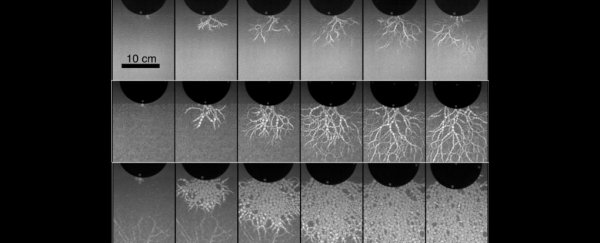When a meteor or a missile strikes the ground at a high velocity, it's easy to see the damage on the surface - usually in the form of a gigantic crater. But what exactly is going on following such a collossal amount of force?
A new study led by physicists in the US, who have devised a method for simulating high-speed impacts in the lab, suggests that granular materials such as soil and sand actually get stronger the harder they're hit.
The counterintuitive findings, published in the journal Physical Review Letters, offer new insight into how soil responds to high-speed force, and researchers say it could explain why attempts to produce ground-penetrating missiles that go deeper, simply by going faster, have had limited success.
Essentially, when struck at high speed, the energy travels through the soil so fast that there isn't enough time for the particles to rearrange themselves and give way. Instead, they are forced into one another, creating resistance.
"Imagine you're trying to push your way through a crowded room," explains study co-author Abram Clark, a mechanical engineer at Yale University, in a press release. "If you try to run and push your way through the room faster than people can rearrange to get out of the way, you're going to end up applying a lot of pressure and ramming into a lot of angry people."
To simulate a high-speed impact, the researchers dropped a metal projectile with a rounded tip from a 2.3-metre-tall ceiling into a pit of beads, representing artificial sand.
On impact, the kinetic energy of the falling projectile is transferred to the beads and dissipates as they're pressed into each other below the surface, ultimately absorbing the force of the collision.
To visualise these forces, the researchers used beads made from a clear plastic, which transmit light differently when they're compressed.
When viewed through a basic polarising filters - which are used in photography to reduce glare - the areas that endure the greatest stress show up as branching chains of light, like little white lightning bolts moving through and between the beads. These are called force chains.
While the metal projectile fell into the beads at a speed of 6 metres per second, or nearly 22 kilometres per hour, the team was able to simulate speeds upwards of 1000 km per hour by using beads of varying hardness.
They recorded these impacts with a high-speed video camera, and when they played it back in slow motion, they found that the branching network of force chains buried in the beads varied considerably across a range of impact speeds.
At low speeds, a sparse network of beads carries the brunt of the force, said study co-author and physicist, Robert Behringer, in a press release. But at higher speeds, these force chains grow more extensive, which causes the impact energy to move away from the point of impact much faster than predicted by previous models. This causes new contacts to form between the beads, or granules, and has the effect of strengthening the material.
The work was funded by the US military's Defence Threat Reduction Agency, and will probably lead to the development of new missiles that can dig into Earth to destroy enemy bunkers or weapon stockpiles.
